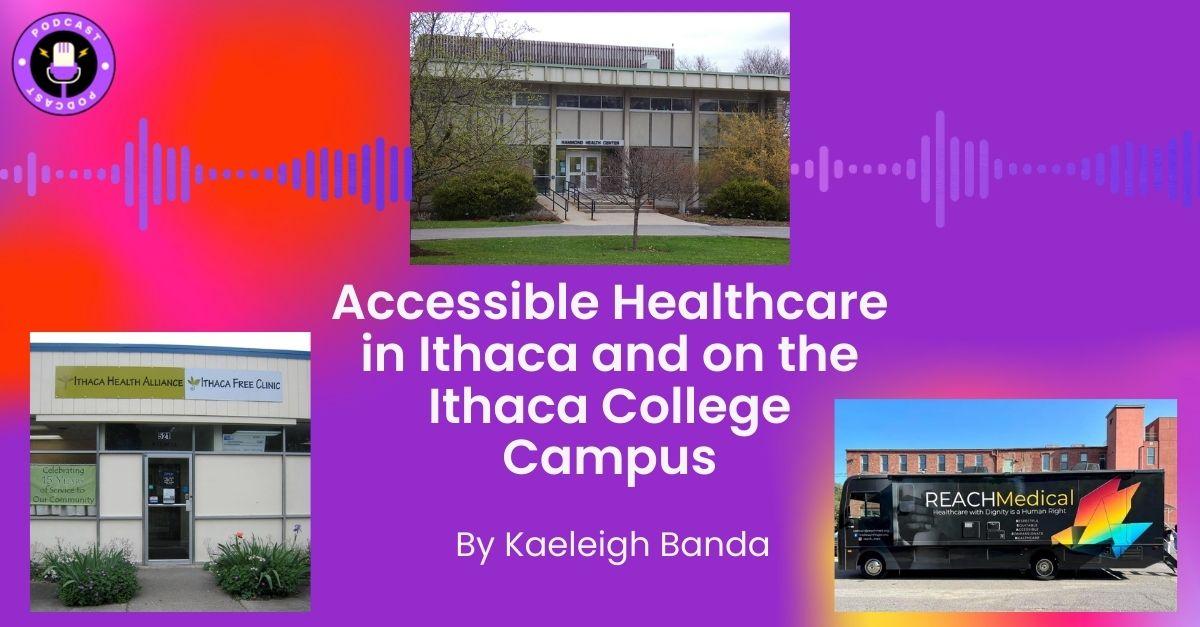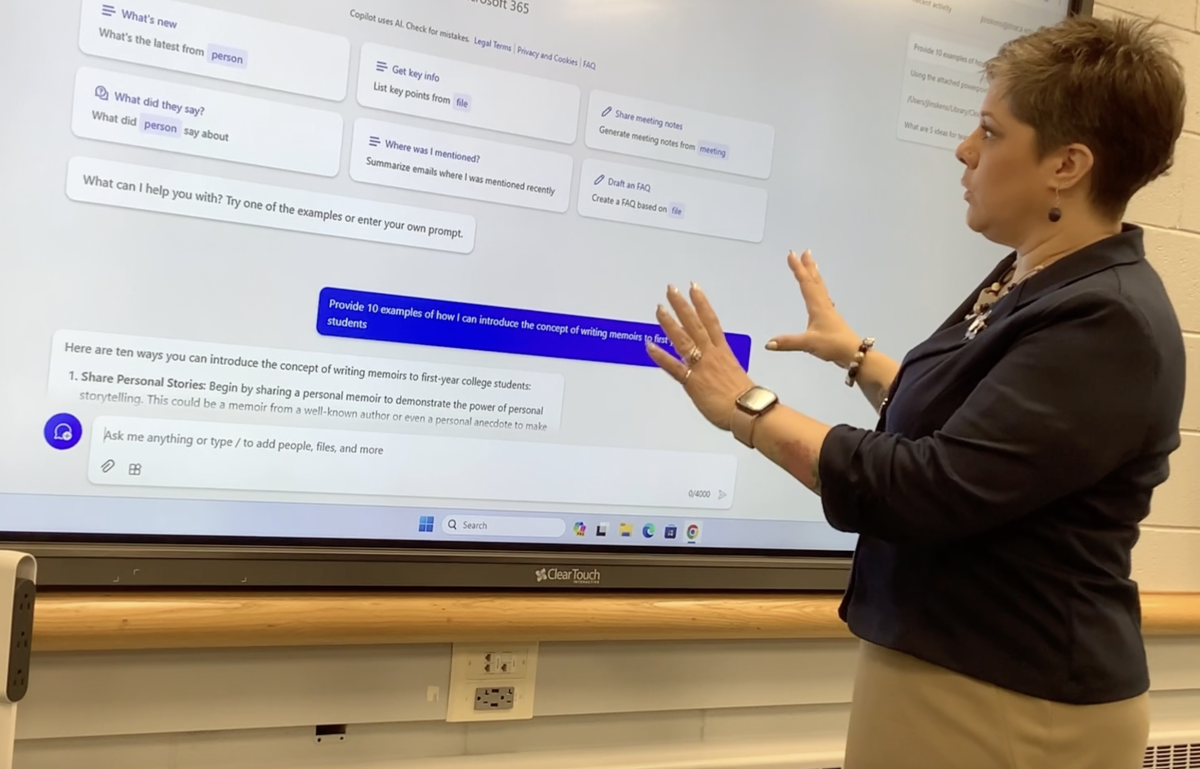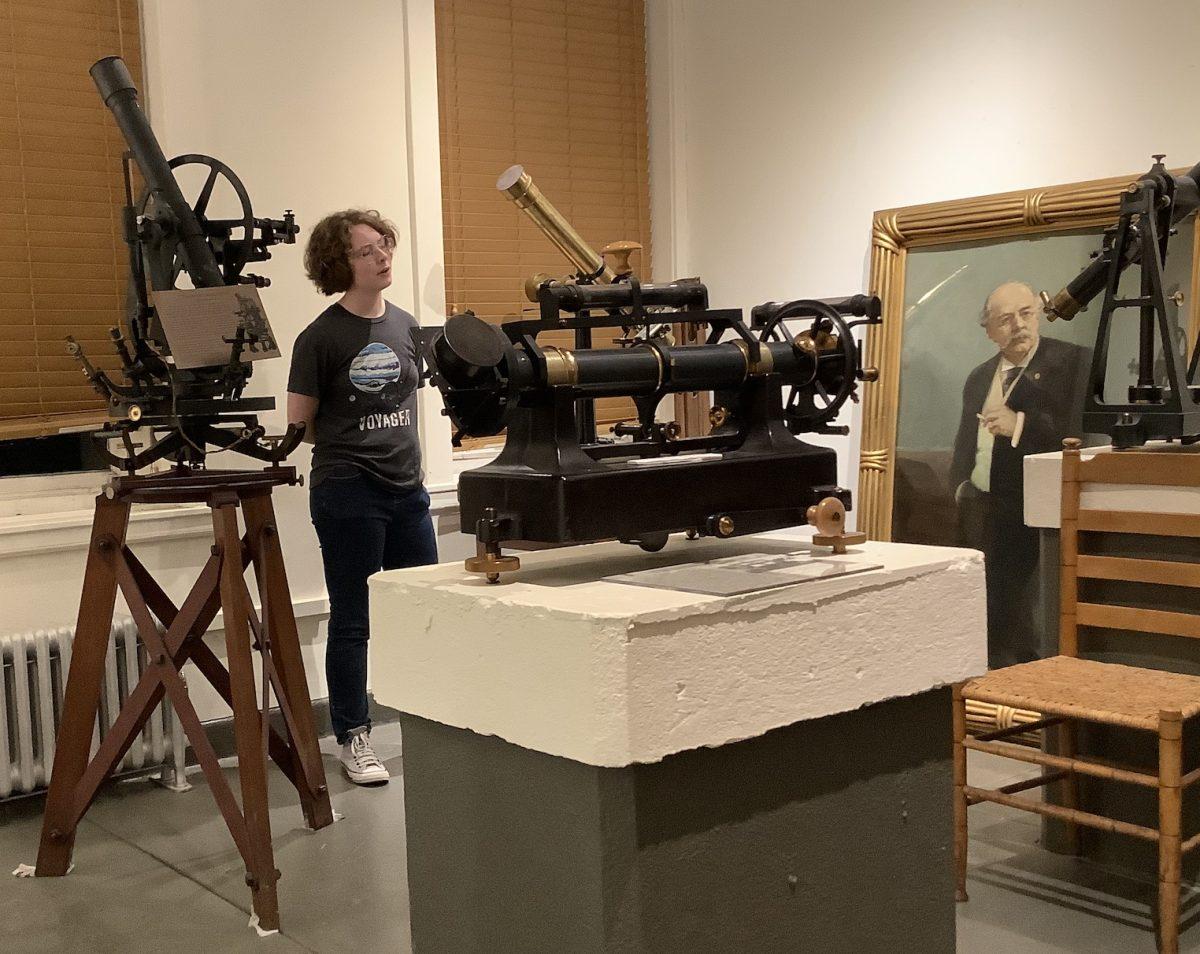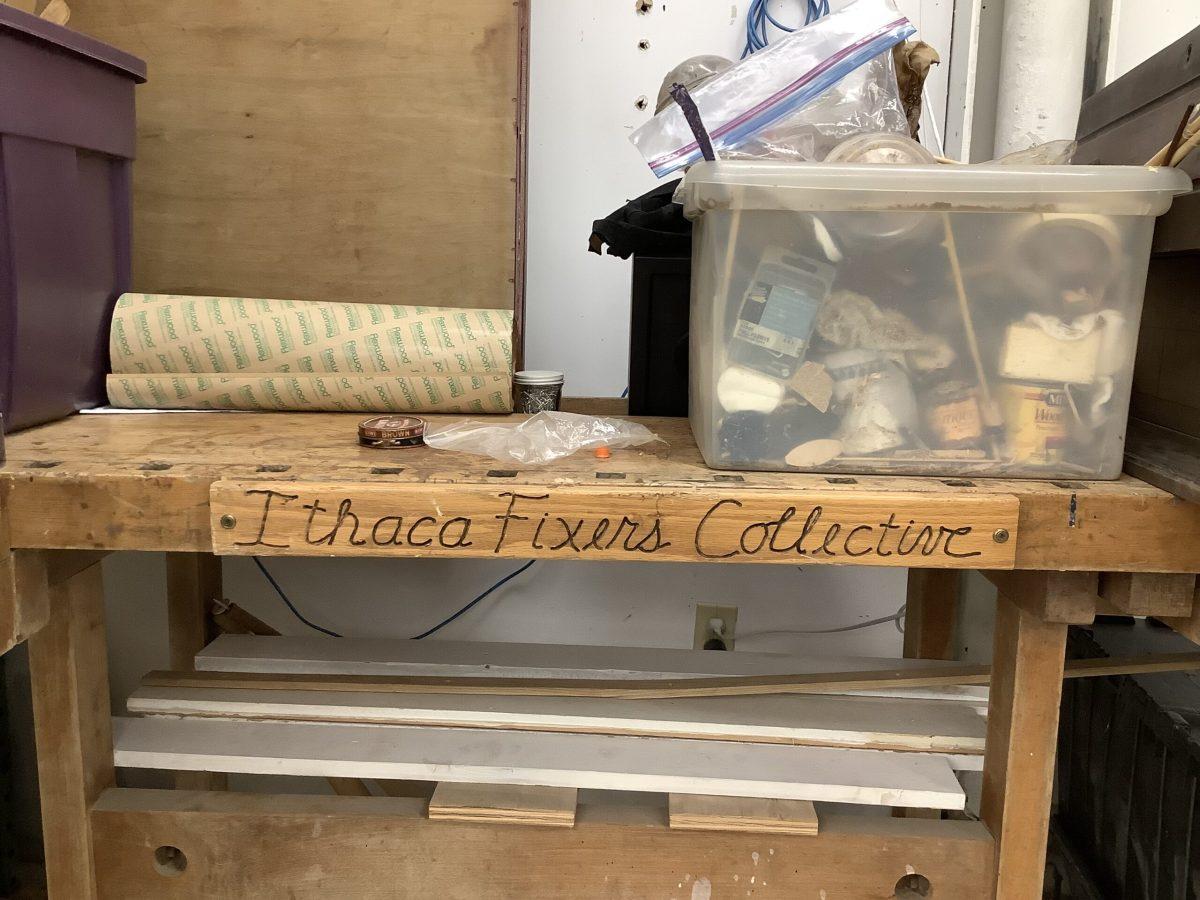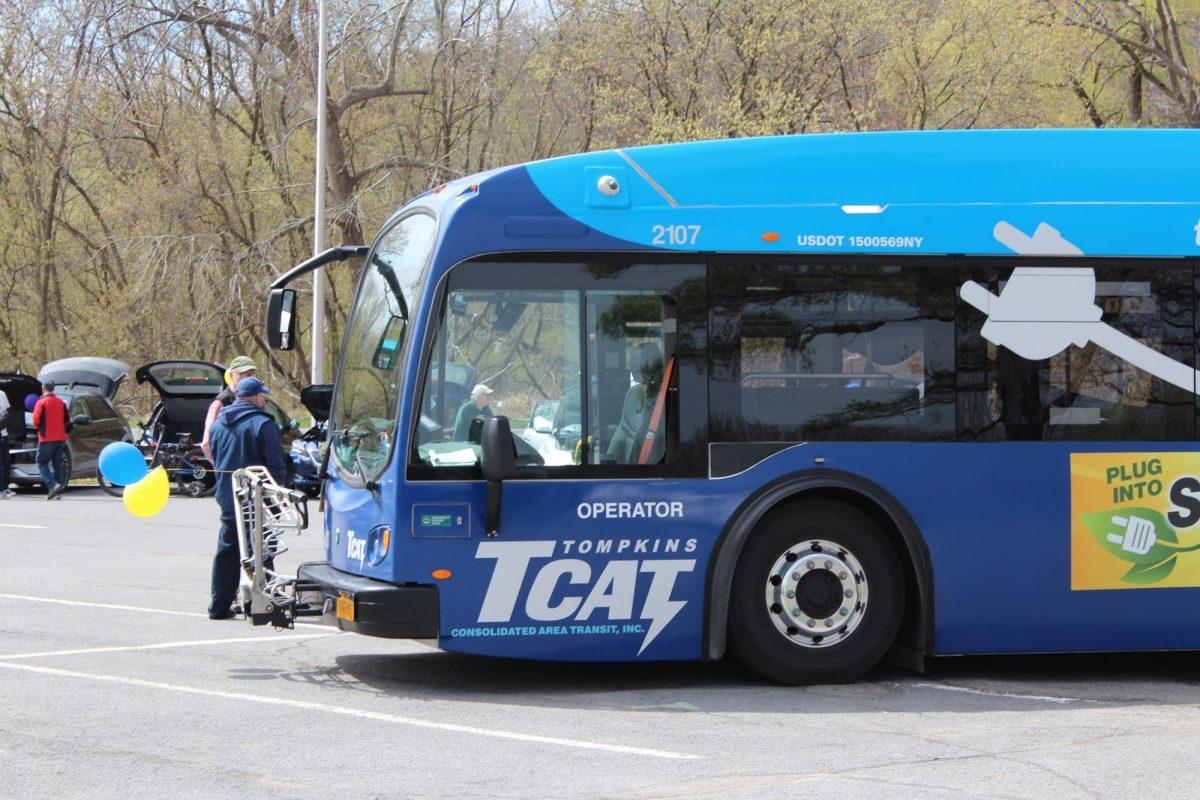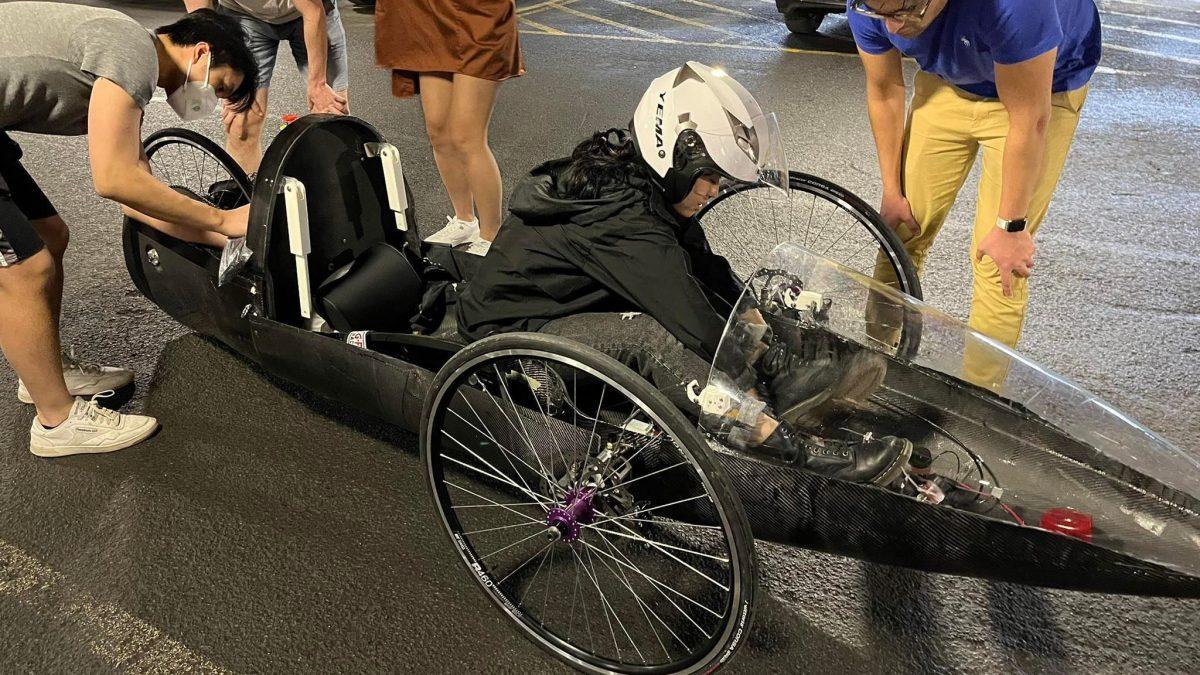
Ed Tech Day returns after pandemic delay

Educational Technology Day returned at Ithaca College for its 30th iteration after a pandemic pause. On Thursday, March 21. attendees explored booths, speakers and tours in Campus Center. Several sessions covered Artificial Intelligence (AI), robotics, information security, modern classroom technology and more. This year, Ed Tech Day was co-sponsored by NYSERNet, a nonprofit organization that works in data and networking technology solutions.
The 29th Ed Tech Day occurred in 2019 and the 30th has been delayed until now due to the COVID-19 pandemic. In the 2024 Ed Tech Day Program, David Weil, vice president for information technology and analytics at Ithaca College, reflected on how much technology has advanced since the first Ed Tech Day in 1991.
“While many of these advancements were barely imaginable by the attendees at the first Ed Tech Day, the need to intentionally think about the ways we use technology to advance our teaching, learning and work guided our conversations then and continue to do so today,” Weil wrote.
— Story by Lorien Tyne
Are you ready for the coming robot overlords? Anyone could be tricked into thinking we are entering our own Orwellian dystopia as Boston Dynamics’ robot walked into the Klingenstein Lounge.
Matt Knight and Deb Cole, members of Boston Dynamics marketing department, were quick to douse any fears of a robotic uprising and started to highlight the ways in which the current revolution in robotics has already enhanced our lives.
The main focal point of Boston Dynamics’ presentation, Spot, is a quadruped robot that resembles a dog. Able to traverse traditionally challenging terrain for robots like sand, mud and stairs, the robot’s legs allow for additional mobility over methods such as tracks and wheels.
On the robot’s back is the ability to mount various payloads. Boston Dynamics offers various arms, cameras, sensors and other devices that they design in house and are rated for adverse environments. Buyers are also able to mount payloads of their own design that can be functionally integrated with the robot through the company’s open source, python-based SDK (operating system).
Matt explained to the attentive crowd about a real world implementation of Spot that highlighted its functionality. British company Sellafield deployed Spot robots in an effort to clean up nuclear waste areas that were not man-accessible. Due to the mobility of the robot and the dexterity of the arm payload, the robot was able to complete a dangerous job in a volatile environment, saving someone from risking their own health to complete.
— Story by Nate Henshaw
Generative AI in Education

3 p.m. — Artificial intelligence (AI) has been a sweeping concern throughout educational spaces as institutions grapple with its use versus claims of academic dishonesty.
Dr. Kavita Bala, inaugural dean of Cornell University’s Ann S. Bowers College of Computing and Information Science, discussed the use of generative AI (GenAI) in higher educational pedagogy.
Bala outlined various initiatives that Cornell has undertaken in order to understand, teach and utilize AI in educational programming.
She said that AI has a “huge societal impact” and that current advancements are comparable to computing technology in the 1990s. Cornell is now introducing two minors, “Technological AI” and “AI in Society”, for students who wish to explore more.
The Cornell AI Initiative has a comprehensive guide for educators, the main points of which are:
Generative AI can be used as a tool for creating deeper learning for students and as an accessibility model
- Educators have a duty to understand AI as it develops and evolves
- The use of AI must be disclosed in educational spaces
- Students and educators have a duty of verification and to check for unintentional plagiarism, as the software pulls from potentially copyrighted data.
For more on the intersections between AI and educational spaces, EdTech Day is hosting a multitude of events. The next session features F. Paul Greene, partner at Harter, Secrest & Emery law firm in Rochester, New York. Greene will be speaking on the legal framework that is being created around AI and how institutions can ethically respond to AI use in educational spaces.
—Story by Chloe Johnston
Cybersecurity is a Growing Field for Students

2:45 p.m. — “AI is a phenomenal, efficient, new way of doing business. It also is terrifying,” said Jonathan Borgesen, a security solutions specialist at ePlus Security as he spoke to students and visitors attending Ithaca College’s Educational Technology Day.
Ed Tech Day at Ithaca was filled with interactive robotics, immersive virtual reality headsets, and important conversations surrounding cybersecurity on campuses and in the workplace. Borgesen spoke alongside Thomas Rodriguez, Manager of Sales Engineering at Varonis Systems to discuss cybersecurity concerns and solutions. Borgesen said new advances in technology such as artificial intelligence and collaboration help to mitigate cybersecurity risks and attacks.
According to Borgesen, data destruction is a main trend analyzed in the tech landscape. Borgesen discussed how ransomware for financial gain by bad actors online works to threaten and disrupt the U.S. economy and that data is more valuable than money.
“If an organization loses its data, it loses its ability to function,” said Borgesen.
Varonis is a data security company that focuses on protecting access to data and its exposure. Rodriguez believes it is important for students to learn about cybersecurity and adds that cybersecurity is a growing field to pursue in the tech industry.
“I think it’s one of the biggest fields…the threats are really growing, and what’s scary about AI is that it could actually build and exacerbate these threats and that is going to really increase the need to be more creative on the security front to protect against these attacks which have never been easier than before.”
—Story by Gabriella Baiano
EdTech relies on student workers

2:30 p.m. — Campus Center is filled with participants for the 30th anniversary Ed Tech Day — its first year since 2020.
Aidan Henderson ‘25, Information Technology’s Audiovisual student manager, is assisting with technological set up and presentations throughout the day. Henderson is a seminar coordinator who is “making sure that everything is running smoothly and helping out [where] needed.”
Members of the IT department picked up shifts on a volunteer basis and are paid one dollar extra for their work today.
Henderson said that he was excited for the return of Ed Tech Day after “hearing about the event for so long” and that he had a particular interest in seeing what vendors are offering throughout the day.

Henderson emphasized that many of the technological showcases are worth checking out, and that he enjoyed Boston Dynamics’ robotic dog, Spot.
Other student workers at the event include members of the Campus Center operations staff Molly Hankinson ‘24 and Sylvia Grosvold ‘25. Hankinson said that Ed Tech Day is one of the “biggest events” she has worked as an operations manager and that the event required “thoughtful planning.”
The event has been running for a few hours now and Grosvold says it has been a success so far.
“All of the gears seem to be running,” said Grosvold, while checking coats for guests.
— Story by Chloe Johnston
The ways Adobe uses Artificial Intelligence

2:15 p.m. — What is the first thing we think of when we think of Adobe? For many, it’s likely Photoshop.
Creative Educator of Adobe, Jesse Lubinsky, says Adobe has the ability to be so much more- especially through the rise of AI. Lubinsky works to find creative spaces in the classroom for students, through the use of technology and a creative lens. His presentation fixated on the different features that Adobe has, demonstrating how AI has the capability to be dangerous and misleading, but if used in a safe way can allow students to understand technology and not fear it.
Discussing Adobe Firefly, which is Adobe’s version of AI and considered the “brain” behind their tools, Lubinsky spoke of howFirefly 1.0 and 2.0, which are a work in progress,are the primary goal of Adobe to ensure a safe environment when it comes to working with AI. “I am both horrified and amazed at the same time,” Lubinsky says in presenting Adobe Firefly to the audience. Moreover, Lubinsky discussed Adobe Express, which is powered through Adobe Firefly. With the mix of Firefly and Express, students can create and design their story with the help of AI.without being overpowered by technology.
“When we think about AI, we are moving from this moment of searching content to creating content, ” Lubinsky said. “”Without critical thinking, you wouldn’t be able to generate images and think of different prompts.”
There is a free version of Adobe Express, simply go to their website. Premium is available as well, but it costs $9.99 monthly.
— Story by Carolina Cedraschi
Let’s go #ishing

2 p.m. — Derek Meixell, chief technology officer for Synergy IT Solutions, led the “Let’s go #ishing” seminar, in the Ithaca Falls Meeting Room. The talk was packed with attendees eager to learn how to avoid manipulation from cyber-attacks.
Phishing is when a fraudulent message is sent from an attacker posing as a reputable company to obtain personal information on the subject. During his talk, Meixell expanded on the different forms of phishing, such as Spear Phishing,
“Spear Phishing is when I’m sending you a message that says, ‘Hey, Bob, looks like you just got a new job. I’m the IT guy at your new facility. Let’s work on getting their computer set up properly,” he said.
This can happen because of a job update on LinkedIn where phishers can see and target potential vulnerable new employees.
“I changed the job. I updated my LinkedIn profile. And two days later, people are like, ‘Hey, looks like you’re just starting out. You’re welcome aboard the company’ and they started fishing,” Meixell said. “So that’s spear phishing, they know what they want, and they know who they’re targeting.”
The audience raised questions about how to deal with Spear Phishing, with the increase in work-from-home positions, and Meixell stressed being wary and reaching out to a trusted source for confirmation.
He reminded attendees that even if it is your company’s IT department, the department should already have information about you that they need and wouldn’t email you asking for sensitive information.
— Story by Hannah Sanson
This initiative is more than child’s play

1:30 p.m. — Ithaca Toys, a cooperation between school and community, is transforming playtime for children in grades K–5. With a focus on hands-on learning and sustainability, they created a detailed activity out of locally obtained wood that inspires creativity while also building a connection to nature.
Lee Kaltman, the visionary behind Ithaca Toys, draws inspiration from a poignant moment between his son and grandfather in Puerto Rico.
“My son was 5 years old, and he was outside with his grandfather from Puerto Rico,” said Kaltman. “He had dominos, and his kid was counting the dominos dots. As an educational game theory, it was something.”
This simple yet profound interaction became the catalyst for Kaltman’s journey into educational play. Partnering with South Hillam Elementary and organizations like the Ithaca Generator, Kaltman embarked on a journey to transform raw wood into educational tools. Through mentorship and hands-on workshops, students learned woodworking skills while producing sets for local schools and libraries.
Dakota Tseng, Ithaca Toys’ sales agent, stresses the importance of the company’s commitment to using locally produced wood.

“Ithaca Toys values education and sustainability through locally produced wood. Each item has a unique appeal and connection to our community,” Tseng said.
The initiative doesn’t just benefit children, its boosters say, it also provides meaningful employment opportunities for individuals with disabilities through Challenge Workforce Solutions. By tapping into the talents of the community, Ithaca Toys has flourished, now boasting two skilled craftsmen and even hiring high school students from New Roots Charter School.
For inquiries or collaboration opportunities, contact [email protected].
— Story by Summar Lowe
Encouraging technological and non-technological creativity across disciplines
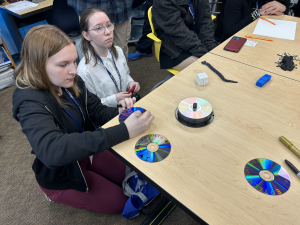
11:30 a.m. – Ash Bailot, makerspace facilities coordinator, took Ed Tech Day attendees on a walkthrough of Ithaca College’s Makerspace. The tour included multiple small hands-on projects for attendees to take part in.
The Makerspace is a work space that offers students, staff and faculty access and education to a range of creative tools for both academic and personal use.
Among the available technology are 3D printers, Dremel DigiLab Laser Cutters, Cricut Tools and other hand crafting tools which can be used in a variety of disciplines like woodworking, jewelry making, fabric arts and embroidery.
Students at Ithaca College make a variety of products, like personalized buttons and fidget toys. The space also encounters students from across academic disciplines that utilize the facility for classes. For example, many occupational therapy students use the 3D printers to create tools for field use. While the amount of visitors varies from day-to-day, Bailot estimates that an average of 20 people use the facilities per day.
Bailot first got involved in the Makerspace during their senior year at Ithaca College before being hired as temporary facilities coordinator. Though approaching the technology within the facility can be daunting, Bailot said that the space is open to all skill levels and provides training. This Makerspace is just one within Ithaca, and is the only one on Ithaca College’s campus. Bailot said they are pushing for another space in the library.
— Story by Rachel Williams
The evolution of print and the cloud

11 a.m. – Toshiba’s Russ Seager, senior solutions specialist, and Alex Madden, print management specialist, came to Ithaca this Ed Tech Day to discuss emerging innovations in printing, including data management and the merging of cloud technology with Multifunction Printers (MFPs) in their talk, “Unlocking Tomorrow’s Potential.”
While it is a common misconception that print is a dying industry, Seager and Madden maintain that it is more relevant than ever. The presentation emphasized how switching from desktop printers to MFPs can greatly improve productivity, increase security, cut costs and improve sustainability.
Toshiba’s MFPs use automatic encryption as a security measure, ensuring end-of-life security benefits. MFPs also allows the use of cloud technology to manage and monitor devices and share security information remotely — no technician required. This cuts down on human resources and creates quicker problem solving.
Ithaca College uses Papercut, which partners with Toshiba, to manage its their print services. Individuals sign into the software, which then keeps track of who, when and where things are being printed.
Using this data allows for Toshiba to make suggestions of where to place or replace MFPs and desktop printers, which has a great impact on the digital carbon footprint. Toshiba’s partnerships with Ithaca College and Printreleaf, a reforestation program, plants a tree for every 8,330 pages printed; Toshiba also has a zero-waste sustainability initiative that focuses on toner cartridge recycling.
This talk was attended by employees in higher education, including IT employees at Ithaca College and across SUNY schools. Jen Helstein, who works for SUNY Oswego, said she found the presentation helpful because Oswego is currently transitioning to Toshiba and she manages Pheros — a program similar to Papercut used across SUNY institutions.
— Story by Rachel Williams
Connecting with students through social media
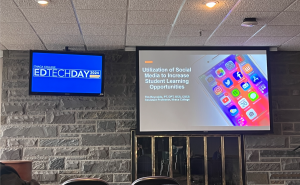 Tim Reynold’s Presentation entitled “Utilization of Social Media to Increase Student Learning Opportunities.” (Photo by Alecia Solorzano/Ithaca Week)
Tim Reynold’s Presentation entitled “Utilization of Social Media to Increase Student Learning Opportunities.” (Photo by Alecia Solorzano/Ithaca Week)
10:30 a.m. – Students exist in a revolutionary age of social media which not only can impact their social lives but also their schooling and education. Utilizing social media in the classroom is not only accessible to this generation of students but it can also bolster creativity.
That was the message from Assistant Professor Tim Reynolds, whose talk kicked off the 30th EdTech Day at Ithaca College. In Reynolds’ talk, “Utilization of Social Media to Increase Student Learning Opportunities,” he emphasized how TikTok helped him to better connect with his students and aid them in their learning process. It also benefits them outside of the classroom.
“In today’s day and age, students have changed,” Reynolds said, “Between the utilization of technology at early ages but also the concept of remote instruction over the last several years, I think that faculty members should take advantage of trying to meet their students where they’re at versus assuming that they’re going to learn in traditional academic settings…it allows them to access some education literally in the palm of their hands.”
TikTok, where Reynolds has amassed over 874,000 followers since March 2022, is considered one of the most popular platforms at the moment. However, this is under threat of disappearing as a social media site and also a tool for American students to utilize. Reynolds suggests other platforms such as Instagram and X for continuing this content as well.
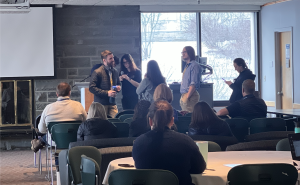 Professor Reynolds follows up on his talk with attendees. (Photo by Alecia Solorzano/Ithaca Week)
Professor Reynolds follows up on his talk with attendees. (Photo by Alecia Solorzano/Ithaca Week)
“It’s beneficial for learning, it improves creativity and some curiosity for learning. It creates an excitement for learning too because it’s something that’s not currently being done,” Reynolds told the audience.
“Granted, the utilization of social media is not for everybody and it’s something that some faculty members might be against, per se. So, I don’t think it’s going to be appropriate for every single course. But, if you’re willing to step outside your traditional pedagogical approaches and try to challenge yourself for the betterment of your students, I think it’s going to be worth it,” he added.
Reynolds is not the only professor at Ithaca College who utilizes social media, specifically TikTok, to connect with students. Professor Peter Johanns at the Roy H. Park School of Communications has also gained over 1.6 million followers on his satirical account. While his page isn’t necessarily used for educational purposes, it does aid in creating connections with students and furthering their interaction with the material outside of the classroom.
— Story by Alecia Solorzano



